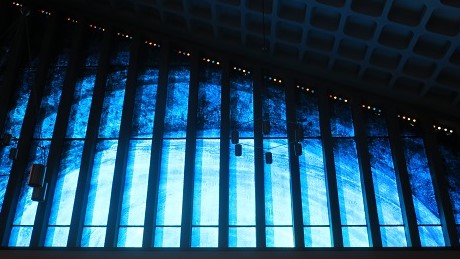The John Piper Windows
John Piper
John Piper (1903 – 1992) was an English painter, printmaker and stained-glass window designer. He was also an official WW2 war artist who worked with John Betjeman and Ben Nicholson, reaching prominence in the post-war period. His best-known works are probably those located at Coventry and Chichester Cathedrals and the Tate Gallery.

A Brief History
The original church (dating from 1868) was bombed in the Second World War. Only part of the building remained standing and this included some window fragments. A new church, entirely modern in design, was commissioned and planned to link the few remaining elements of the old structure. On 26 September 1962 the Parochial Church Council approved the suggestion of the architect, Robert Potter, that John Piper be invited to design the new windows.
John Piper travelled to Bristol in March 1964 and discussed the themes for the windows with Fr Luetchford (the incumbent between 1946 and 1968). The principal themes of the Tree of Life and the River of Life were agreed and sketches prepared. The Diocesan Advisory Council were ‘unconvinced’. However after some negotiations the plans and sketches were approved.
The Technique
These are not stained glass windows. Piper described these windows as being rather ‘like painting on canvas’ and that they should be ‘painted in situ’. The fibreglass ‘canvas’ was created by Gillespie Associates in Farnham. Onto this Piper poured the coloured resins, creating large sections without the use of ‘leads’, even where colours changed.
As an alternative to the traditional way of creating windows Piper said:

“There is a prejudice against it (this technique) at present; it is thought to look too synthetic or ‘plastic’, at any rate for churches. But as good artists use the medium more and more, there is no doubt it will gain ground. In view of the richness of colour and variety, there is probably quite a future for it.”
The only other church in which this technique was used by Piper is St Matthew, Southcote, Reading, where he created two diamond shaped windows. However, these appear to be ‘a design afterthought’ and are not an integral part of the whole architectural concept as the windows are here at All Saints.
This ‘medium’ does have problems however. The ultra violet wavelength of sunlight causes fibreglass to deteriorate, and the constant movement of the windows, through expansion and contraction (due to the heat of the sun), causes further damage. This movement can be heard as a ‘crackling’ sound when the sun shines on the windows. Additionally, the polyester resin can be seen to be slipping in some parts of the windows as fifty years of deterioration and gravity begin to have an effect.
Significance of the Windows
These windows are a recognized ‘National Treasure’, providing, as they do, the single most important expression of the artist’s skill and intention in his work with a new medium and in applying new techniques. This is the only church in the United Kingdom in which each and every window is a Piper work of art.
Furthermore, Piper’s designs incorporated the ideas associated with the commission and the ‘spirit of the place’ for which they were commissioned. This combination of idea and spirit is revealed here, almost to perfection.
The John Piper Designs ‘Stained Glass’ (1967)
Overview
The Design of John Piper is bold and simple. The window over the Lady Chapel (balcony) is nothing but blue, varying in texture and density. Borders everywhere are pin-points of colour set in blue. The Sanctuary has two columns of red reaching the full height of the building. The strong vertical axis is emphasised at both the East and West ends of the building.
The main design is reserved for the tall west wall (or Baptistry) windows which go to the very roof. Blue is maintained and on the left we see the ‘sinuous golden form of the River of Life’ and on the right ‘the Tree of Life with its branches curving upwards, studded with red and gold fruits’.
The River of Life and the Tree of Life (West Windows)
 |
|
‘Then the angel showed me the river of the water of life, as clear as crystal, flowing from the throne of God and of the Lamb down the middle of the great street of the city. On each side of the river stood the tree of life, bearing twelve crops of fruit, yielding its fruit every month. And the leaves of the tree are for the healing of the nations.
No longer will there be any curse. The throne of God and of the Lamb will be in the city, and his servants will serve him. They will see his face, and his name will be on their foreheads. There will be no more night. They will not need the light of a lamp or the light of the sun, for the Lord God will give them light.
And they will reign for ever and ever.’
Revelation 22:1 - 5 |
|
 |
Lady Chapel (South) Window
 |
|
In the beginning God created the heavens and the earth. Now the earth was formless and empty, darkness was over the surface of the deep, and the Spirit of God was hovering over the waters. And God said, “Let there be light,” and there was light. God saw that the light was good, and he separated the light from the darkness. God called the light “day,” and the darkness he called “night.” And there was evening, and there was morning—the first day.
And God said, “Let there be a vault between the waters to separate water from water.” So God made the vault and separated the water under the vault from the water above it. And it was so. God called the vault “sky.” And there was evening, and there was morning—the second day.
Genesis 1: 1 - 8 |